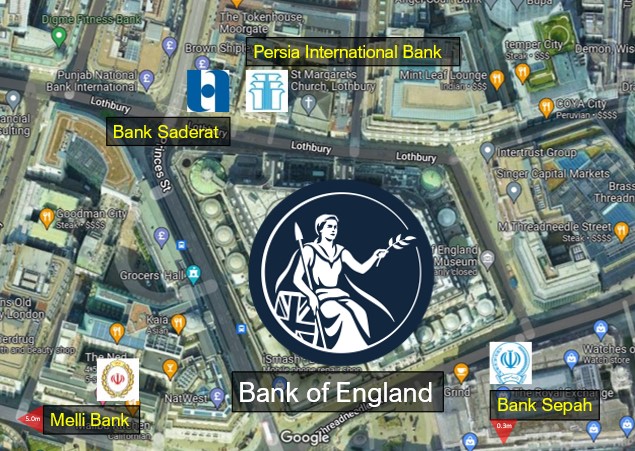London Blacklists Russia’s Banks, Iran’s Get Green Light
In the wake of Vladimir Putin’s invasion of Ukraine, Britain moved decisively against all Russian banks, freezing $336 billion (£258 billion) - a bigger assets freeze than any other country including the U.S.
This is laudable and yet throws Britain’s contrastingly limp policy against Iranian banks into sharp relief. There are more Iranian bank branches operating in London’s ‘square mile’ financial district than any other city outside Iran: three are within spitting distance of the Bank of England. And all are sanctioned by the United States for their terror ties.
Iran’s Bank Saderat is literally across the street from The Old Lady of Threadneedle Street. One of Iran’s top three state-owned banks, Bank Saderat has helped the Iranian regime funnel money to multiple terrorist proxies, including Hamas, Hezbollah and Palestinian Islamic Jihad.
Immediately next door is Persia International Bank plc (PIB), formerly known as Iran Overseas Investment Bank. Its two shareholders are Bank Mellat and Tejarat Bank, both designated by the U.S. Treasury’s Office of Foreign Assets Control (OFAC). Bank Mellat has facilitated the movement of millions of dollars for Iran’s nuclear program since 2003 and while the UK ceased business with them in 2009, its PIB subsidiary continues to operate on British soil.
A ten minute stroll away, Londoners will find Bank Sepah plc, which has provided “direct and extensive financial services” to Iran’s ballistic missiles and development agencies including Aerospace Industries Organization (AIO) and its subsidiary, Shahid Hemmat Industrial Group (SHIG).
Further west in well-heeled Kensington is Melli Bank plc, the most malignant of all. Bank Melli was sanctioned by the U.S. in 2018 for its support of Iran’s notorious Islamic Revolutionary Guard Corps (IRGC) and billions of dollars equivalent in funds have flowed through IRGC-controlled accounts at Bank Melli.
Since the mid-2000s, Bank Melli increasingly provided services to Iranian military-related entities as they became further involved in all aspects of the Iranian economy. The IRGC-Quds Force has used Bank Melli to dispense funds to Iraqi Shia militant groups, and Bank Melli’s presence in Iraq was part of this scheme.
These Shia militant groups include the notorious Iran-sponsored terror group, Kataib Hezbollah, whose leader Abu Madhi al-Mohandes was killed in the same drone strike that neutralized Qasem Solemani in 2020. In March 2020, Kataib Hezbollah missiles targeted a military base 17 miles north of Baghdad. The attack killed three—two Americans and one British soldier—and injured at least 14 others.
Kataib Hezbollah is responsible for “some of the most lethal attacks against U.S. and coalition forces throughout the [Iraq War].”
Not surprisingly, each of these institutions are subject to U.S. secondary sanctions, which are targeted at firms outside U.S jurisdiction.

London’s Iran Banks– Bank Saderat and Persia International Bank are located directly opposite Britain’s central bank. Bank Sepah is 0.3 miles south. Melli Bank is 5 miles west. (Credit: Google Maps)
And yet London’s Iranian banks proudly flaunt their British bona fides. All proclaim to be authorized by the Prudential Regulatory Authority (PRA), regulated by the Financial Conduct Authority (FCA) and covered by the Financial Services Compensation Scheme (FCSA). This cloak of legitimacy provides these institutions with the cover they need to funnel capital to the world’s leading sponsor of terror. They represent a financial as well as a moral hazard to the unsuspecting British public and UK firms alike, who may easily misunderstand that these banks are not normal reputable institutions.
Starting with Iran’s rogue banks, it is high time for Boris Johnson and Foreign Secretary Liz Truss to display the same sense of moral purpose against Tehran as they have shown against Moscow.
Receive Iran News in Your Inbox.
Eye on Iran is a news summary from United Against Nuclear Iran (UANI), a section 501(c)(3) organization. Eye on Iran is available to subscribers on a daily basis or weekly basis.